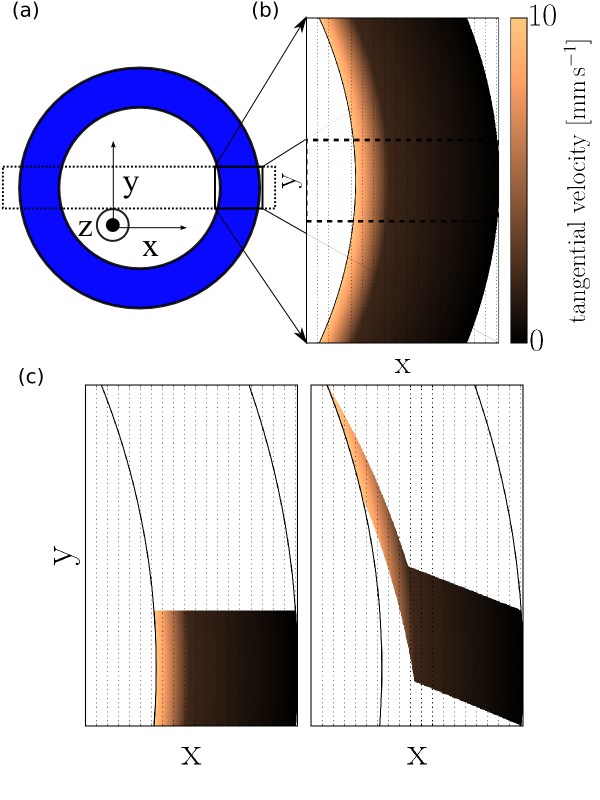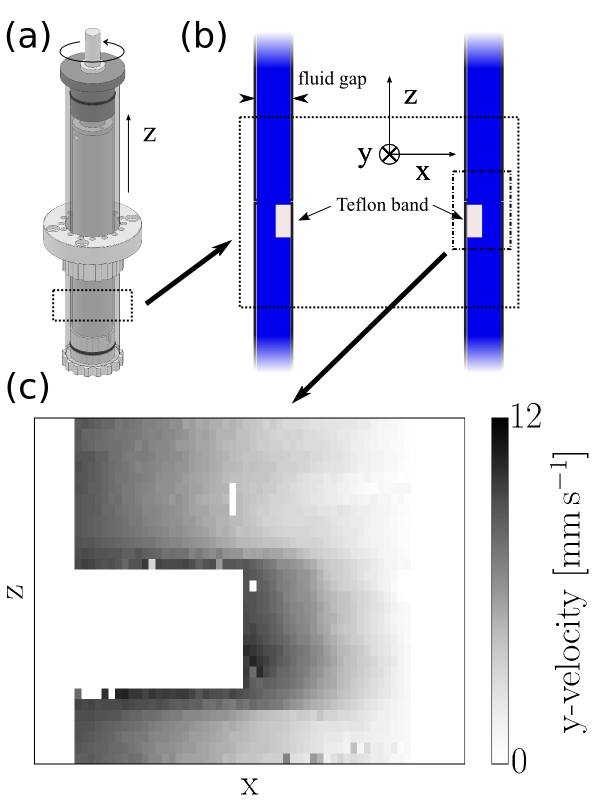Fast RARE Velocimetry in Cylindrical Couette Geometry
- MacDiarmid Institute for Advanced Materials and Nanotechnology, Victoria University of Wellington, SCPS, Wellington, New Zealand
Cylindrical Couette cells are a common tool for the characterization of complex fluids in rheology and soft matter research. For these geometries the liquid under study is sheared in the annulus between differentially rotating concentric cylinders (see Fig.2a). It is well known that complex fluids sheared in such cells can exhibit complicated flow behaviour that is far from being fully understood today. Hence, spatially resolved measurement of fluid velocities via NMR can provide useful insight into the underlying dynamics of the fluid flow.
Here, we present a series of improvements and alterations to a PGSE-RARE (Pulsed Gradient Spin Echo - Rapid Acquisition with Relaxation Enhancement) sequence [K2] that is capable of generating 2D velocity maps of fluids sheared in a cylindrical Couette geometry with high temporal and spatial resolution. These improvements put particular focus on the accurate measurement of the tangential velocity component of the circular flow that does not comprise the Cartesian nature of the NMR imaging process. Several challenges have been identified and overcome. The first concerns the appropriate selection of the fluid volume over which velocity information is accumulated as controlled by the slice selection process. Numerical calculations based on simple model fluids and experimental results lead to an optimal slice thickness appropriate for the velocimetry sequence (see Fig.1b). The second difficulty is related to the motion of the fluid during the k-space acquisition as considerable pixel in-and outflow can be present due to the circular nature of the flow (see Fig.1c). In order to get further insight into this effect an MRI simulation program, which is based on the Bloch equations, has been written. Results from the simulation and experiments suggest that a centric k-space scheme, where the centre of k-space is sampled at the beginning of the acquisition process, is advantageous for the flow conditions in question.

The small extent of the fluid gap for the cells in use is an additional challenge. In this respect, a variant of the velocimetry technique has been developed that offers ultra high resolution in the gap direction (down to 16 μm), necessary for a detailed description of the flow profile for complex fluids. For fluids with a low self-diffusion coefficient this allows the acquisition of high resolution flow maps as shown in Fig.2c for a polymeric liquid. In the case where the NMR signal is originating from faster diffusing spins, the acquisition of a 2D k-space is impeded by the diffusive attenuation under the strong imaging gradients and thus rendering the sequence essentially 1D. Another improvement concerns the design of the Couette geometry that allows for a shear experiment under controlled thermal conditions by providing space for airflow along the outer cylinder wall during the experiment.

These improvements help to draw a refined picture on the dynamics of a certain complex fluid [K1] (known as 10% CPCl) that has recently been studied by K. Feindel and P. Callaghan [F1] with a similar velocimetry technique. The `10% CPCl' system is a wormlike micellar solution, which exhibits shear banding, an effect where the flow partitions into two bands of differing viscosity under certain shear conditions. In particular, it shall be shown that an improved spatial resolution of the 1D ultra high resolution method furthers the understanding of the banding process and the dynamics of the interface between the two bands. The NMR study is supported by results from an ultrasonic speckle velocimetry (USV) [G1] method. Considerable overlap between the USV and NMR technique is found underlining the efficiency of the NMR improvements.
Cylindrical Couette cells are a common tool for the characterization of complex fluids in rheology and soft matter research. However, complex fluids sheared in such cells can exhibit complicated flow behaviour that is far from being fully understood today. Hence, spatially resolved measurement of fluid velocities via NMR can provide useful insight into the underlying dynamics of the fluid flow.
Here, we present a series of improvements and alterations to a PGSE-RARE (Pulsed Gradient Spin Echo - Rapid Acquisition with Relaxation Enhancement) sequence [K2] that is capable of generating 2D velocity maps of fluids sheared in a Couette geometry with high temporal and spatial resolution. These improvements put particular focus on the accurate measurement of the tangential flow component which does not comprise the Cartesian nature of the NMR imaging process. To this end, averaging effects related to the choice of slice thickness and the appropriate k-space trajectory with regards to voxel in- and outflow are analyzed. Considerations are supported by numerical calculations and simulations as well as experimental evidence. Furthermore, a high resolution variant of the PGSE-RARE sequence is presented that allows resolutions of up to 16 μm in the direction of the fluid gap in comparison to about 100 μm typically achieved with the PGSE-RARE method (see Figure).

These improvements help to draw a refined picture on the dynamics of a certain complex fluid [K1] (known as 10% CPCl) that has recently been studied by K. Feindel and P. Callaghan [F1] with a similar velocimetry technique. The `10% CPCl' system is a wormlike micellar solution that exhibits shear banding, an effect where the flow partitions into two bands of differing viscosity under certain shear conditions. In particular, it will be shown that an improved spatial resolution furthers the understanding of the banding process and the dynamics of the interface between the two bands. The NMR study is supported by results from an ultrasonic speckle velocimetry (USV) [G1] method. Considerable overlap between the USV and NMR technique is found underlining the efficiency of the NMR improvements.
- [F1] K. Feindel and P. Callaghan, (2010), Anomalous shear banding: multidimensional dynamics under fluctuating slip conditions, Rheologica Acta
- [G1] Gallot, T. et al. , (2013), Ultrafast ultrasonic imaging coupled to rheometry: Principle and illustration, Review of Scientific Instruments
- [K1] Kuczera, S. et al., (2015), Anomalous Shear Banding revisited with Rheo-NMR and Rheo-USV, Rheologica Acta
- [K2] Kuczera, S. et al., (2015), Advances in RARE-Velocimetry for Cylindrical Couette Flow, Submitted to Journal of Magnetic Resonance
